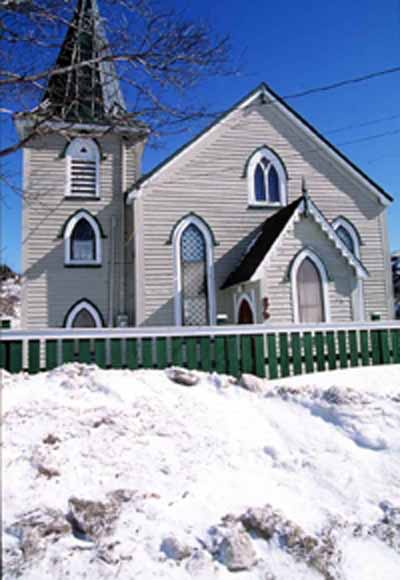Christ Church / Quidi Vidi Church National Historic Site of Canada
St. John's, Newfoundland and Labrador

Façade
© Parks Canada Agency / Agence Parcs Canada, J. Butterill, 1994.
Address :
100 The Boulevard, Quidi Vidi, St. John's, Newfoundland and Labrador
Recognition Statute:
Historic Sites and Monuments Act (R.S.C., 1985, c. H-4)
Designation Date:
1966-10-26
Dates:
-
1842 to 1842
(Construction)
-
1890 to 1890
(Significant)
-
1842 to 1966
(Significant)
Event, Person, Organization:
-
James Purcell
(Architect)
Other Name(s):
-
Christ Church / Quidi Vidi Church
(Designation Name)
Plaque(s)
Existing plaque: 100 The Boulevard, St. John's, Newfoundland and Labrador
While church services were held at Quidi Vidi from an earlier date, in 1834 Anglicans, Methodists, and Congregationalists combined to build a church here. Co-operation failing, the original building fell into decay and the property into the hands of the Anglicans. This church, built to the simple cruciform plan of Henry Purcell of Cork, was opened by Bishop Spencer in 1842. Transitory fame came with its selection as location for scenes in the first Canadian feature film, The Viking (1931). By 1966 a dwindling congregation led to its closure and the building was acquired by the Newfoundland Historic Trust.
Description of Historic Place
Christ Church / Quidi Vidi Church National Historic Site of Canada is a modest, 19th-century, Gothic Revival style wood church, based on a modified cruciform plan with a side tower. It is located on a fenced lot on a steep hill overlooking the harbour in the former village of Quidi Vidi, now part of the city of St. John’s. The building is no longer used as a church and the interior has been altered. Official recognition refers to the building on its property at the time of designation.
Heritage Value
Christ Church / Quidi Vidi Church was designated a national historic site of Canada in 1966 because: it is representative of the architecture of an early 19th-century out port villages of a type rapidly disappearing.
The heritage value of this site resides in its design, form and materials. Christ Church / Quidi Vidi Church was opened in 1842 as a chapel of ease for St. Thomas’s Anglican Church in St. John’s. Its original design by James Purcell, an architect and builder, was based on a cruciform plan with Gothic Revival detailing, an architectural form and vocabulary favoured by the Anglican Church from the mid-19th century to the beginning of the 20th century. Christ Church / Quidi Vidi Church was modified by a series of additions in the 19th and 20th centuries, including the addition of a bell tower in 1890. In its wood construction, scale, plan and evolution, it is consistent with churches constructed across the island of Newfoundland in outport communities.
Source: Historic Sites and Monuments Board of Canada, Minutes, October 1966.
Character-Defining Elements
Key elements that relate to the heritage value of the site include: its location on a steep hill overlooking the harbour; its Gothic Revival style, including the cruciform plan of the church body under a crossed gable roof, the three-bay facade with central door flanked by pointed arch windows under drip mouldings, and its square side tower, capped by a spire; its elements typical of outport construction, notably its relatively small size, the entry through a storm porch, and its interpretation in wood of traditionally masonry construction with elements such as wooden Gothic Revival style detailing and clapboard siding.